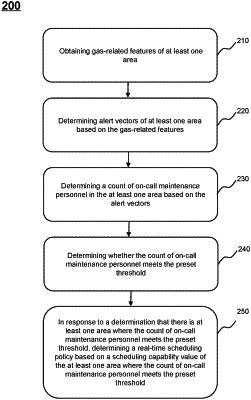| CPC G06Q 10/06312 (2013.01) [G16Y 10/35 (2020.01); G16Y 20/20 (2020.01)] | 6 Claims |

|
1. A method for maintenance scheduling and management based on gas safety, wherein the method is implemented by a smart gas Internet of Things system for maintenance scheduling and management based on gas safety, and the smart gas Internet of Things system includes a smart gas user platform, a smart gas service platform, a smart gas safety management platform, a smart gas sensor network platform and a smart gas object platform, and the method is executed by at least one processor of the smart gas safety management platform, the method comprising:
obtaining gas-related features of at least one area, wherein the gas-related features include gas consumption features;
determining alert vectors of the at least one area based on the gas-related features by methods for feature extraction, which include multilayer perceptrons, convolutional neural networks, and residual networks, the alert vectors including a leakage alert value;
determining a count of on-call maintenance personnel in the at least one area based on the alert vectors;
determining whether the count of on-call maintenance personnel meets a preset threshold; and
in response to a determination that there is at least one area where the count of on-call maintenance personnel meets the preset threshold, determining a real-time scheduling policy based on a scheduling capability value of the at least one area where the count of on-call maintenance personnel meets the preset threshold, wherein the real-time scheduling policy includes a scheduling quantity and a scheduling location when on-call maintenance personnel is scheduled, and determining the scheduling capability value includes:
performing multiple rounds of iterative update on the scheduling capability value, wherein when an updated scheduling capability value meets a preset condition, the update ends; and
determining the real-time scheduling policy based on the updated scheduling capability value, wherein the multiple rounds of iterative update includes:
in a first round: determining an initial scheduling capability value of each node of an area map, and using the initial scheduling capability value as a scheduling capability value to be updated, wherein the area map includes a plurality of nodes and a plurality of edges, each node denoting each area, each edge denoting a relationship between two connected nodes, a feature of the node includes a count of current on-call maintenance personnel in the area, a feature of the edge includes a distance between the two nodes and a weight value, the weight value being related to household features of the two nodes connected by the edge;
in a tth round (t larger than 1): updating the scheduling capability value to be updated of each node based on a preset algorithm, using an updated scheduling capability value of each node in the tth round as a scheduling capability value to be updated of each node in (t+1) round, wherein the updated scheduling capability value of node i in the tth round is determined based on the updated scheduling capability value of the node i in the (t−1)th round, a change value between an updated scheduling capability value of a node connected to the node i and a scheduling capability value before update of the node connected to the node i, and a feature of an edge connected the node i.
|